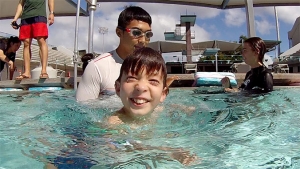A swim program that started two years ago with seven children with Autism Spectrum Disorder (ASD) and five University of Hawaiʻi at Mānoa student volunteers has blossomed into a group of 24 children with ASD and 24 UH students as part of a required laboratory section of an Introduction to Adapted Physical Education class.
The program provides children with ASD 10 weeks of swimming lessons two days a week during the fall and spring semesters. UH students enrolled in the class, learn about ASD, how to plan and teach appropriate swim lessons to children with ASD, and then have the opportunity to apply the information in the laboratory experience.

Autism is the fastest-growing serious developmental disability in the United States. More than 1,800 individuals have been identified as having ASD in Hawaiʻi public schools.
The College of Education project is a partnership funded by the Hawaii Autism Foundation and managed by Kelle Murphy, an associate professor in the Department of Kinesiology and Rehabilitation Science.
Everyone benefits
“It has been rewarding to see the improvement in both swimming skills, comfort level and social skills of children with ASD along with the excitement of the UH students when their child progresses and they realize that they are a part of the process,“ said Murphy. “It been a great learning experience for everyone involved.”
Swimming skills are critical because drowning is the leading cause of death among individuals with ASD, according to the National Autism Association. Parents of the program also see the benefit having their child learn how to swim.
“This program is exceptional,” said Amy Carrasco, a parent of two autistic children. “Dr. Murphy and the instructors that we work with are phenomenal. Where they were at the beginning to where they are now is truly remarkable.”
Julianne King, president and co-founder of the Hawaii Autism Foundation, added, “Many children with ASD wander and are non-communicative. Being surrounded by water, Hawaiʻi’s statistics for these accidental drownings could surpass the national average.”
Learn more about the program at the College of Education’s website.

